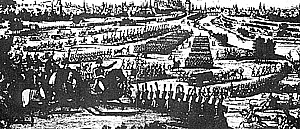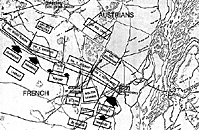 Following our discussion in Part One of this series our generals-elect have confided their grand-tactical plans to paper and we can now review their concepts of the operation to see if we can single out an area or areas to reproduce on the table top. As the defending player, and also first on the scene, we will reproduce the Austrian plan first as follows:
Following our discussion in Part One of this series our generals-elect have confided their grand-tactical plans to paper and we can now review their concepts of the operation to see if we can single out an area or areas to reproduce on the table top. As the defending player, and also first on the scene, we will reproduce the Austrian plan first as follows:
AUSTRIAN ESTIMATE OF THE SITUATION
Enemy Forces: It is estimated that the enemy will have under his command 2 1/2 Corps comprising 98 battalions, 65 squadrons, and 24 companies of artillery.
Friendly Forces: We have, at the present time, 64 battalions of infantry, 64 squadrons of cavalry and 27 companies of artillery.
Mission: Cover Linz and hold on to the main bridge over the Danube in order to allow the Archduke Charles to cross to the southern bank and link up with our forces. We are also to cover the Linz-Vienna road through Ebelsberg and secure the crossings of the Traun River.
Concept of the Operation: We will accomplish our mission by taking up defensive positions along the line roughly Scharnlfer-Schnarnlinz-Klein Munchen. We are in the unfortunate position of defending parallel rather than perpendicular to, our line of communications, the Linz-Enns-Vienna road. As a result, I have determined that we will attempt to cover Linz and the crossing as long as possible, but the Linz-Enns road will be our primary defense, including the bridge over the Traun. We can afford to lose Linz, because the Archduke can cross the Danube further down, but the Linz-Enns-Vienna road must be protected.
Organization of Forces: The only changes to the current organization are as follows:
5th Korps Husarregiment Kleinmayer is assigned to Brigade Radetzky. Grenzinfanterieregiment Gradiskaner is assigned to Brigade de Felso-Kubinyi.
6th Korps Grenzinfanterieregiment Warasdin-St. Georger is assigned to Brigade V. Provencheres.
Chevaulegersregiment O'Reilly is assigned to Brigade V. Nordmann.
AUSTRIAN OPERATIONAL ORDERS
6th Korps: Defend line running from the long woods south of Lipl southeast to Klein Munchen.
Brigade V. Provencheres (-) has the mission of holding Klein Munchen. Grenz IR Warssdin-St Georger is detached from the brigade and will be posted in the woods northeast of Mahrunterberg. If pressed, the regiment will withdraw slowly to and through the main battle line and return to its brigade in Klein Munchen.
Division v. Kottulinsky has the mission of defending and holding a line running from Scharnlinz-Klein Munchen.
Division v. Jellacic has the mission of defending and holding a line running from the long woods south of Lipl to Scharnlinz.
Kav. Brigade v. Nordmann will occupy a position to the northeast of Scharnlinz along the main Linz-Enns road. The brigade mission is to support Div. v. Kottulinsky.
5th Korps: Defend line running from Scharnler southeast to the 6th Korps.
Brigade Felso-Kubinyi: Occupy a position in the south end of the long woods south of Lipl. The brigade will hold its position until hard pressed, then withdraw slowly to the main battle line. There they will assume hold orders.
Division v. Lindenau: has the mission of holding in sector.
Division Reuss-Plauen: has the mission of holding in sector.
Kav Brigade Radetzky: occupy a position immediately to the southeast of Staurergid. The brigade's mission is to support Div. v. Lindenau, and Div. Reuss-Plauen.
Chevaulegersregiment O'Reilly: will occupy a position on the right of Div. Reuss-Plauen and will act as flank security, and a link between the army and Linz.
2nd Reserve Korps: will occupy positions northeast of the Linz-Enns road between the villages of Reisebauer and Abdacker. The Korps will act as army reserve.
It may become necessary during the battle to withdraw to a position which affords greater protection for the Linz-Enns road and the Traun bridge at Ebelsberg. If this becomes the case, the following are the division orders:
Bde v. Provencheres: continue to hold Klein Munchen.
Div. v. Kottulinsky: continue to hold in sector.
Div. v. Jellacic: withdraw to a line running from Scharnlinz to the northwest corner of the large woods southeast of Reisebauer. Hold new line.
Div. v. Lindenau: withdraw to a line running from the northwest corner of the large woods northwest to Beitl. Hold new line.
Bde Felsb-Kubinyi: withdraw to the woods northwest of Beitl, and hold them.
Div. Reuss-Plauen: withdraw to a line running from the woods northwest of Beitl to Sasthausen. Hold new line.
Kav Bdes Radetzky and v. Nordmann will continue to support their respective Korps.
2nd Res. Korps: withdraw to a position between Waringer and Eckmayer.
FRENCH ESTIMATE OF THE SITUATION AND OPERATIONAL ORDERS
Viewing this vast array of troops as their own forces arrived on the battlefield, the French under Massena made the following appreciation:
Enemy Forces: The enemy entrenched before us is believed to consist of the V and VI Austrian Corps d'Armee commanded by Prince Louis. They cannot amount to more than 50,000 men and 12,000 satires. They appear to be covering both the route to Vienna through Ebensberg and also the south eastern approaches to Linz. They must therefore, expect to be reinforced by Prince Charles through Linz.
Friendly Forces: The Emperor is coming up to support us within the next two days with the bulk of the army. He will not be on hand, however, to stop Prince Charles from crossing at Linz to this bank tomorrow unless we drive Prince Louis away, or into the fortress of Linz itself.
Mission: We have been ordered to disperse Prince Louis' forces and seize the outlets to Linz so that Prince Charles army cannot cross there. We will also clear the high road to Vienna by seizing Ebensberg and its long bridge over the Traun if possible.
Concept of the Operation: Marshal Lannes' Corps will consist of the Divisions of Claparede, Demont, and Thaureau and the light cavalry of LaSalle. They will engage the enemy right wing along the heights from the outskirts of Linz on the west up to the Chausse connecting the Linz road and the Wells road. Once our attack has pierced the enemy center, he will storm the heights in echelon from his right to his left to roll back that wing of the Austrian army.
Marshal Messena's Corps will consist of the Divisions Molitor, Boudet, Legrand, Cara, St. Cyr, and St. Hilaire, as well as the light cavalry of Marulez.
The heavy cavalry divisions of Marshal Bessieres wili support the attack by Marshall Massena's Corps. Boudet's division will engage and screen the town of Klein Munchen, while Molitor and Legrand storm the hamlet of Schaunlinz. St. Cyr will attack in support of Molitor and Legrand on their left flank while St. Hilaire will be the army reserve initially.
The heavy cavalry supported by Marulez will draw up with their right resting on the Wells road and will attack in support of Molitor and Legrand on their right flank. Once Schaunlinz is taken they must attack and disperse the enemy's left wing forces and seize the Linz road. St. Hilaire will reinforce whichever action is required upon my command only. The attack to commence at 0900 upon the firing of the signal battery.
In case of a reverse, Marshall Lannes will cover the withdrawal of the army towards Wells.
Let us now examine the area of utmost interest in this battle. As can be seen from the French plan they intend to throw 18 Bns against Scharnlinz supported on one wing by 13 Bns and on the other by over 70 squadrons.
They also intend to tie up the rest of the Austrian army by pinning attacks. The Austrians have countered by having Jellacic's division (12 Bns + 2 grenz Bns) with parts of Kottulinsky's Division (say 6 sqdns) available to hold against this mass. They can also eventually bring up their Reserve Corps (5 Bns and 24 sqdns) and Nordmann's cavalry bde (24 sqdns).
It would seem that Boudet's 7 btns could contain Provencheres in Klein Munchen and it also seems reasonable that Lannes (42 btns and 11 sqdns) could engage Prince Louis' Corps (28 btns and 16 sqdns) and not allow any of them to support the action around Scharnlinz.
Areas
 With these thoughts in mind, we would probably recommend that a game be played on a table centered on the area outlined and marked as A. This assumes that the St. Georges Grenze Rgt. has already been driven in (which might make for an interesting scenario to be played well prior to the game).
With these thoughts in mind, we would probably recommend that a game be played on a table centered on the area outlined and marked as A. This assumes that the St. Georges Grenze Rgt. has already been driven in (which might make for an interesting scenario to be played well prior to the game).
We don't attempt to prescribe table sizes since that will depend on what figure organization and ratio you use, nor do we dictate when the Austrian reserves would come up as that will depend on your ground vs. time scale. What we have done, however, is to take a large scale ground tactical operation and reduced it to playable proportions (and enjoyable ones we hope).
Alternatives to this recommendation abound and I'm sure your own interests and thoughts would weigh heavily on your choice. We would like, however, to suggest a couple of alternatives of our own. Players with low figure ratios (1-10 or 1-20) who use historical organizations (i.e. very large Austrian battalions and large French cavalry squadrons) may wish to compress the table to B to allow more linear spacing of your units especially since most such rules (at least that I have observed), tend to rely on figure removal and relatively few turns to reach an issue.
Players with Grand Tactical games but who lack the number of units envisioned here, and I must confess, it would be a strain to come up with 60 plus French squadrons might consider narrowing the frontage slightly as portrayed by table C. They could then concentrate on the close in fight to seize Schaunlinz and break the Austrians wide open -- while still allowing some of the French and Austrian cavalry to operate in the open plain to the east of that town. Again the availability and timeliness of reserves for both sides would depend on your ground scale and off table movement rates plus whatever delays you impose on ordering up major supporting units.
As mentioned in the first part of this series, if sufficient interest is present we will play out one of the scenarios available from this situation and report our results here in a follow-up article. The important point is that with very little work in preparing the overall situation one finds numerous playable possibilities (why not play Lannes' attack on Prince Louis -- let it start at say 2PM after Massena has made his main attack and see what each player can do in a situation that neither really asked for). Use these possibilities to provide you with a continuing serial of scenarios, large and small, and tailored to your needs.
Back to Table of Contents -- Courier Vol. 1 #3
To Courier List of Issues
To MagWeb Master Magazine List
© Copyright 1979 by The Courier Publishing Company.
This article appears in MagWeb (Magazine Web) on the Internet World Wide Web.
Other military history articles and gaming articles are available at http://www.magweb.com